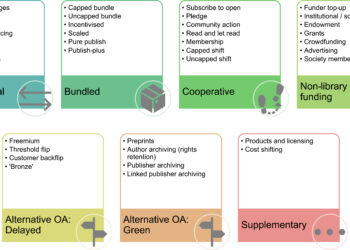 Everyone knows that an organization, any organization, needs a strategy and a plan that articulates that strategy, but for many organizations the task of developing such a plan can be difficult, even overwhelming. Part of the reason for this, perhaps the largest part, is a misunderstanding of what strategy is; part of it may be having been exposed previously to cumbersome planning processes.
Everyone knows that an organization, any organization, needs a strategy and a plan that articulates that strategy, but for many organizations the task of developing such a plan can be difficult, even overwhelming. Part of the reason for this, perhaps the largest part, is a misunderstanding of what strategy is; part of it may be having been exposed previously to cumbersome planning processes.
It’s not unusual for an organization to approach the planning process as though it were a multi-year extension of the budget (“How much will we spend on paper clips and staples in March 2017?”), which is absolutely the wrong way to go about this. Or some organizations work through the plan on a department-by-department basis, attempting to determine exactly how the very same organization will look and operate several years from now, without taking on the bigger, the strategic question: Will we be involved in activities that will not require these departments in the first place? No wonder so many people dread the very words “strategic plan” as they promise little more than a great deal of work for no practical benefit. Like the terms “synergy” and “value-added,” “strategic plan” seems like something foisted upon poor, mission-based organizations by the unfeeling and unthinking graduates of business schools.
Can’t we stop all this strategic planning nonsense and get back to work?
How can you tell if you are going about the strategic planning process in the wrong way? Here is a rule of thumb: if creating a strategic plan seems like something outside your ordinary business activity, you’re doing it wrong. Strategic planning is not something foreign and external to an organization but in fact the organization’s primary activity. It is what an organization does — it plans for the future and then figures out how to get there. “How to get there” is another term for what we do every day — talking with authors, developing software platforms, negotiating with vendors, recruiting the best people, and satisfying customers. The strategy is the why, the teleology of all these activities; the plan is the roadmap.
In the not-for-profit world, the temptation not to think strategically is very strong. I would add that the great differentiator between for-profit and not-for-profit organizations is not so much in the quality of personnel or in the goal of being financially sustainable but in the depth and importance of strategic planning. For-profits are better at this because the end-point of their activities is clearly stated and rarely challenged: to grow in economic terms. (It doesn’t hurt that their boards hold them accountable.) Many not-for-profits confuse their missions with their strategy, which often, even typically, results in short-term thinking. A mission to feed the poor can begin with feeding the poor family next door; and it can end there as well if pursuing the mission exhausts all of an organization’s resources. A strategy for feeding the poor necessarily thinks in bigger terms: Why is poverty a persistent problem? What structural changes can be made to make the solution to this problem permanent?
Embarking on a strategic planning exercise properly involves three questions, and the answers to these questions comprise the organization’s vision, mission, and strategy respectively.
1. What will the world in which the organization operates look like in a specific amount of time? It’s important to set a timeframe for a strategy. As for how specific, the term I like to use for publishing companies is five years, which is close enough to be tangible, but also far off enough to allow for significant changes in priorities and direction. For example, while some people believe that all STM journals will someday be Gold open access, few clear-headed analysts think that such a wholesale change is likely within a five-year time frame. Thus, with regard to a five-year picture for STM journals, it seems reasonable to assume a pluralistic environment, with some Gold journals and some traditional publications. Now, determining what those proportions will be is another matter, and that also is an important aspect of the plan. But such a planning process also requires us to think about the growth or decline of other elements. What about NIH funding? How will altmetrics change the landscape? How will social media interact with the activities of scholarly communications? These questions are great in number and not always easily evaluated, but a picture of the future world in which a publisher will operate is critical to determine what should be done today.
That picture of the world 5 years from now is the company’s vision.
2. What role do we want the organization to play in that future world? Let’s say we envision that the actual consumption of scholarly content will be mediated by large consumer technology companies such as Amazon, Google, and Apple. Do we want to become suppliers to these companies? Do we instead wish to become direct marketers, bypassing the mediators? Or do we propose to lead a consortium of like-minded publishers to establish a rival ecosystem? When we paint the picture, we have to paint our own place in it.
That place in the picture is the company mission. Note that this is a different kind of mission from what not-for-profits typically espouse. It is organizational, not cultural in nature. An anthropology society may have a declared mission of disseminating knowledge about its field far and wide, as well it should; but there are many different roles to play in the future of anthropology publishing, and the society has to determine which one to pursue. It is unlikely that a professional society and its publishing branch will have the same organizational missions because they face different ecosystems, even though they are aligned in terms of their cultural mission.
3. How do we get there from here? The current organization is living today. It has staff, products, and customers. But the mission for five years out suggests that some things will have to change; at the least, it suggests that some operations that are now in place will have to be enhanced. If we were to say that our mission is to have a 10% share of all research articles in chemistry in five years, and we don’t even have a chemistry program in place today or we have under 1% of the market, how will we direct our organization to fulfill its mission within the allotted time frame?
The strategy is how to get there from here.
The strategic planning process thus begins with a great deal of brainstorming. What will the world look like in five years? Solicit opinions inside and outside the organization, fill up the white boards. It can be a great deal of fun. And the process provides insight into current operations, as every participant is invited to evaluate his or her daily activity against the backdrop of the broader discussion.
The second stage (defining the mission) requires some hard-headed thinking. What can we really achieve in that time period? What will the competition be doing? It would be unrealistic for PLoS to propose to take over the world of trade publishing (not that they would want to), but it may be realistic to propose a goal of replicating PLoS ONE in humanities and social science fields. No organization can do everything, but few organizations can afford not to try to do more than they are doing now.
Finally, in crafting strategy, the business types get to play a large role. What size organization do we need to meet our goals, to fulfill our mission? How will we finance this? What kind of operation will we have to be in five years? The strategy requires that the organization work backward from the five-year vision to the present reality.
An organization that does not engage in this kind of process becomes hostage to evolving events. While we cannot snap our fingers and demand that the world in five years look just the way we want it to, we can determine what role we want to play in that world and can work hard to make that happen. Let’s step before the white boards and begin.
Discussion
6 Thoughts on "Strategic Planning and the Not-for-Profit Publisher"
My view is that traditional strategic planning is not feasible during the kind of revolution that scholarly publishing is going through, because the future is simply too unpredictable. I propose something called Chaos Management instead. See my little essay on this:
http://www.craigellachie.us/powervision/Mathematics_Philosophy_Science/Chaosman.html
In an externally driven environment what is needed is organized responsiveness, which is very different from contingency planning, much less strategic planning. It means being prepared for surprises.
There is a further complication when the organization, such as a university press, is embedded within a larger one that also engages in strategic planning, wherein the press’s planning must mesh with the larger organization’s and whose terms are dictated by the framework of the plan for the entire university. Thus, for example, on many campuses these days the press’s strategic planning must be accommodated to the strategic planning of the library, which is its partner (as with California) or administrative overlord (as at Michigan and Penn State).
I find it interesting how
“organization” (in its singular and plural form) is used 3 times in the very first sentence alone.
As someone who’s done my share of strategic planning for both commercial and not-for-profit publishers, I’m frequently struck by how many managers think that strategic planning is “really hard” and should be someone else’s job. I agree wholeheartedly with your point if the planning process seems divorced from normal management processes then it’s doomed. We’ve seen too many strategic plans treated as term papers: complete the homework assignment and turn it in. When this happens, the result is likely to die in a file cabinet. To be useful, strategic plans should be designed as live tools that can help guide a business on a month-to-month basis. For anyone interested, we developed a simple tool that may be helpful http://www.greenhousegrows.com/publications3/ (Please pardon the commercial, and, of course, always interested in feedback.)



